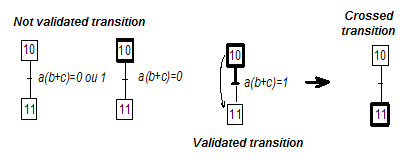
A brief reminder about Grafcet :
The GRAFCET is a functional diagram. Its goal is to graphically describe the various behaviors of a sequential automatism.
The GRAFCET describes the cycles by a succession of STEPS and TRANSITIONS ; ACTION are associated with steps, and transitions are associated with RECEPTIVITIES.
1. Steps
A step characterizes the behaviour of one portion or of the totality of the command process.
The conditions of evolution between steps, called receptivities, take into account ,among all information coming with the automatism , only those which are necessary at a given instant of time for causing an evolution or a change.
During the execution of the process, the steps are activated in sequence one after the other. Among the steps, some are activated initially at the beginning of the operation: they are the initial steps.
2. Actions associated with the step
One or more actions can be associated with each steps .They are carried out when the step is activated.
These actions can be of various kinds :
• start up the rod of a jack ;
• start a timer ;
• set a memory to 1 ;
• ...
This action can also be conditional to additional criteria for the step associated with the action.
3. Transitions between steps
The transitions represented by oriented connections indicate the possible evolution of active steps.
A transition can be validated only when the immediately preceding step is active.
4. Receptivities associated with transitions
With each transition is associated a logic condition called receptivity which can be either true 1 or false 0.
The crossing of a transition can occur only when this transition is validated and when the associated receptivity is true.
This crossing activates the following step and deactivates the preceding step.
The receptivities use various information :
• the state of the sensors, the state of end stops ;
• the end time of a timer ;
• a comparison ;
• ...
5. Basic structure
To respond to the imperative functional requirements, a cycle is often made of :
• a selection of sequences: choice of sequences to be executed ;
• simultaneous sequences evolving independently at the same time ;
• jumping steps ;
• resumption of sequence.
Reminder of the Grafcet rules
Rule 1
Initialization at the beginning of operation specifies the active steps. They are activated conditionally and on the Grafcet encircled with a double square.
Rule 2
A transition is either validated or not validated. It is validated when all the immediately preceding steps are active. It can be only crossed when it is validated and that the receptivity associated with the transition is true.

Rule 3
The crossing of a transition activates all the immediately following steps and deactivates the immediately preceding steps.
Rule 4
Several transitions witch are simultaneously crossable are crossed simultaneously.

Rule 5
If during the operation, a step must be simultaneously activate and deactivated, it remains active.
Note : the time duration of crossing of a transition can never be rigorously null, even if, theoretically (rules 3 and 4), it can be made as small as one wants. The same is true for the duration of activation of a step.
When using the automaton, make sure that a step remains active during at least one cycle (synchronous method).
The Grafcet is a simple practice and powerful method for approaching the design of industrial automatisms.